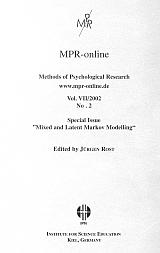

 |
 |
Impressum |
Jürgen Rost (Ed.)

Methods of Psychological Research
IPN
Multivariate analysis of categorical data is a field of statistical research that has been neglected for many years and - to a certain extent - still is. The predominance of statistical models for quantitative variables in the social sciences is in some contradiction to the fact that data collected in sociology, psychology, and education are usually categorical and not quantitative. Rolf Langeheine was the first one who published a German textbook on multivariate analysis of qualitative data (1980). Since that time he has addressed issues of categorical data analysis that raised this area of statistical analysis to the level of advanced quantitative methods in many publications. Log-linear models turned out to be the alternative to simple chi-square tests for independence or chi-square decomposition methods. Automatic interaction detection methods were investigated by Rolf Langeheine before they became a standard method as part of the SPSS-system (chaid). Latent class analysis was defended against configural frequency analysis in a mutually respectful dispute with our highly esteemed teacher and mentor Gustav Lienert. In a countabless number of model specifications, the broad scope of latent class analysis was shown: specifying multivariate path models, defining error of measurement, analyzing different groups of persons simultaneously and establishing the categorical counterpart to structural equation models. The relationships of latent class analysis to scaling models like the Guttman or the Rasch model usually proved the latent class model to be the more general one that covers others as special cases. Markov models are the straightforward extension of categorical data analysis methods, when measurement of change comes into the focus. Rolf Langeheine contributed to this methodology by making Markov models latent and mixed and mixed latent at the same time. These extensions made the Markov chain approach capable of modeling any kind of change from simple mover-stayer models to advanced latent state trait models for categorical data. Needless to say that these extensions were also done on the basis of latent class analysis. This special issue of MPR-online is dedicated to latent Markov models and it honors Rolf Langeheine on the occasion of his retirement. He has been working at the Leibniz Institute for Science Education (IPN) for nearly a quarter of a century. He has been involved in two kinds of academic battles: the fight for the most general model (which he won in the field of Markov models) and the fight for the best fitting model (which cannot be won because new data are coming up as new models do). In the future, we will have to remind ourselves to continue searching for a better fitting model. It may be that the times are changing now, and the fit of the data to the model becomes more important than the fit of the model to the data. You don't see the difference? If the model is to fit the data, it is an academic challenge not to be put to rest before the model is found. If the data is to fit the model, it is a matter of the handicraft to collect data that do so. |
| 20.08.2003 |